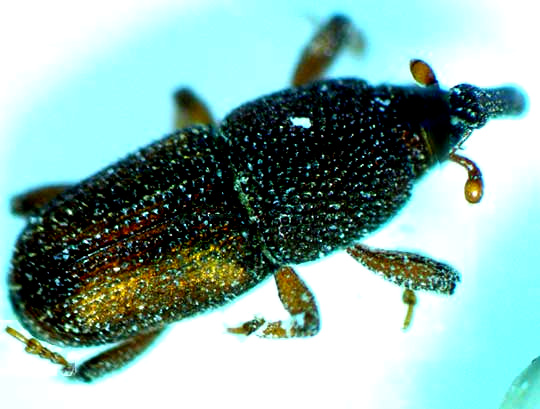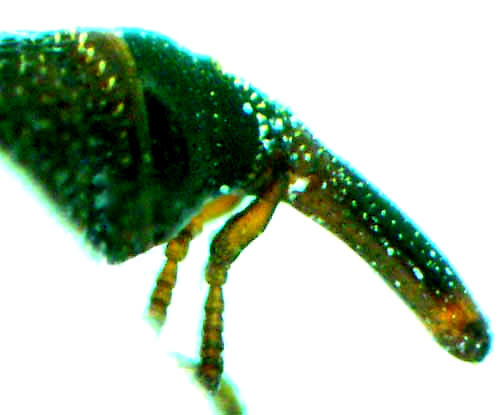Excerpts from Jim Conrad's
Naturalist Newsletter
from the October 20, 2013 Newsletter issued from the Frio Canyon Nature Education Center in the valley of the Dry Frio River in northern Uvalde County, southwestern Texas, on the southern border of the Edwards Plateau; elevation ~1750m (~5750 ft); N29.62°, W99.86°; USA
RICE WEEVILS
Inside a big jar of brown rice one morning some darkish specks caught my attention because they hadn't been there just a few days before. Looking closely, my suspicion was confirmed: Weevils. They were too small for the camera, only 2-3mm long (1/10th inch), so I poured some rice and weevils beneath the dissecting scope, and below you can see what I saw:

The spectacular thing about weevil anatomy is the presence of a long, slender, down-pointed snout. A head picture from the side showing how antennae arise at the base of the snout appears below:

Googling "rice weevil" I learned that really there is such a thing, the Rice Weevil, SITOPHILUS ORYZAE. However, also I found that other very similar weevils found in kitchen jars worldwide also exist, such as the Corn or Maize Beetle and the Wheat or Granary Beetle, all of genus Sitophilus, and it's possible to find, say, Wheat Weevils in rice, and Rice Weevils in wheat. Happily, their general body shapes are slightly different, so by comparing our pictures with those on the Internet I'm fairly sure that our rice-eating weevils are genuine Rice Weevils.
Rice Weevil adults as well as their grub-like larvae feed not only on rice and wheat but also such diverse foods as dried beans, cashew nuts, wild bird seed, bean pods, boxed cereals and macaroni. Females chew a cavity into a seed, lay a single egg and seal it with a secretion from her ovipositor. The larva develops within the seed, hollowing it out while feeding, and eventually pupates inside the same grain before emerging as an adult weevil
I'd always assumed that weevils feed through the tips of their snouts but once I saw that last picture with no hint of mouthparts at the tip I began wondering. Maybe the mouthparts lie farther back, below the snout. But, no, the experts say that weevils feed with small, saw-like teeth at the very tip of their snouts. I read about the Acorn Weevil that, "The tip of the snout is actually a miniature saw, and the weevil places the tip against the {acorn's} shell, circling endlessly around the pivot point until the shell is pierced."
The suddenness with which weevils appeared in my rice jar can be explained by the fact that Rice Weevil females can lay 300 to 400 eggs. Under our hot conditions larvae can mature in a month, and adults often live for seven to eight months. Doing the math, you can see that in just two months it's possible to develop a whole weevil metropolis in a jar.